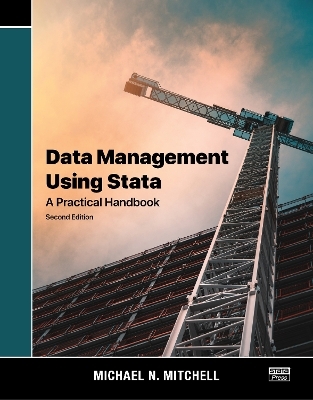
Data Management Using Stata
A Practical Handbook
Seiten
2020
|
2nd edition
Stata Press (Verlag)
978-1-59718-318-5 (ISBN)
Stata Press (Verlag)
978-1-59718-318-5 (ISBN)
This second edition focuses on tasks that bridge the gap between raw data and statistical analysis. It has been updated throughout. It is useful both as a quick reference for solving problems as they arise or can be read as a means for learning comprehensive data management skills.
This second edition of Data Management Using Stata focuses on tasks that bridge the gap between raw data and statistical analysis. It has been updated throughout to reflect new data management features that have been added over the last 10 years. Such features include the ability to read and write a wide variety of file formats, the ability to write highly customized Excel files, the ability to have multiple Stata datasets open at once, and the ability to store and manipulate string variables stored as Unicode.
Further, this new edition includes a new chapter illustrating how to write Stata programs for solving data management tasks. As in the original edition, the chapters are organized by data management areas: reading and writing datasets, cleaning data, labeling datasets, creating variables, combining datasets, processing observations across subgroups, changing the shape of datasets, and programming for data management. Within each chapter, each section is a self-contained lesson illustrating a particular data management task (for instance, creating date variables or automating error checking) via examples. This modular design allows you to quickly identify and implement the most common data management tasks without having to read background information first. In addition to the “nuts and bolts” examples, author Michael Mitchell alerts users to common pitfalls (and how to avoid them) and provides strategic data management advice.
This book can be used as a quick reference for solving problems as they arise or can be read as a means for learning comprehensive data management skills. New users will appreciate this book as a valuable way to learn data management, while experienced users will find this information to be handy and time saving—there is a good chance that even the experienced user will learn some new tricks.
This second edition of Data Management Using Stata focuses on tasks that bridge the gap between raw data and statistical analysis. It has been updated throughout to reflect new data management features that have been added over the last 10 years. Such features include the ability to read and write a wide variety of file formats, the ability to write highly customized Excel files, the ability to have multiple Stata datasets open at once, and the ability to store and manipulate string variables stored as Unicode.
Further, this new edition includes a new chapter illustrating how to write Stata programs for solving data management tasks. As in the original edition, the chapters are organized by data management areas: reading and writing datasets, cleaning data, labeling datasets, creating variables, combining datasets, processing observations across subgroups, changing the shape of datasets, and programming for data management. Within each chapter, each section is a self-contained lesson illustrating a particular data management task (for instance, creating date variables or automating error checking) via examples. This modular design allows you to quickly identify and implement the most common data management tasks without having to read background information first. In addition to the “nuts and bolts” examples, author Michael Mitchell alerts users to common pitfalls (and how to avoid them) and provides strategic data management advice.
This book can be used as a quick reference for solving problems as they arise or can be read as a means for learning comprehensive data management skills. New users will appreciate this book as a valuable way to learn data management, while experienced users will find this information to be handy and time saving—there is a good chance that even the experienced user will learn some new tricks.
Michael Mitchell is a senior statistician working in the area of sleep research as well as working on prevention of child maltreatment with the Children's Data Network. He is the author of three other Stata Press books: A Visual Guide to Stata Graphics, Interpreting and Visualizing regression Models Using Stata, and Stata for the Behavioral Sciences.
Introduction. Reading and importing data files. Saving and exporting data files. Data cleaning. Labeling datasets. Creating variables. Combining datasets. Processing observations across subgroups. Changing the shape of your data. Programming for data management: Part I. Programming for data management: Part II.
| Erscheinungsdatum | 08.06.2020 |
|---|---|
| Verlagsort | College Station |
| Sprache | englisch |
| Maße | 184 x 235 mm |
| Gewicht | 1060 g |
| Themenwelt | Mathematik / Informatik ► Informatik ► Theorie / Studium |
| Mathematik / Informatik ► Mathematik ► Computerprogramme / Computeralgebra | |
| Technik ► Umwelttechnik / Biotechnologie | |
| Wirtschaft ► Volkswirtschaftslehre ► Ökonometrie | |
| ISBN-10 | 1-59718-318-0 / 1597183180 |
| ISBN-13 | 978-1-59718-318-5 / 9781597183185 |
| Zustand | Neuware |
| Haben Sie eine Frage zum Produkt? |
Mehr entdecken
aus dem Bereich
aus dem Bereich
was jeder über Informatik wissen sollte
Buch | Softcover (2024)
Springer Vieweg (Verlag)
37,99 €
Eine Einführung in die Systemtheorie
Buch | Softcover (2022)
UTB (Verlag)
25,00 €
Grundlagen – Anwendungen – Perspektiven
Buch | Softcover (2022)
Springer Vieweg (Verlag)
34,99 €


